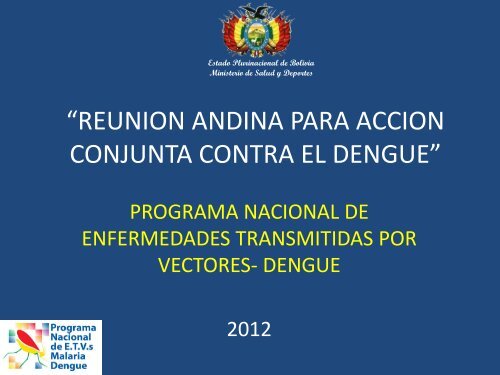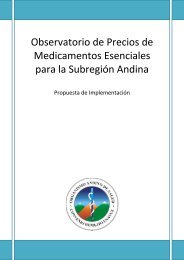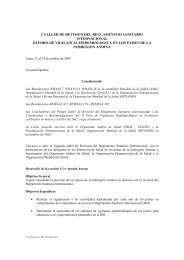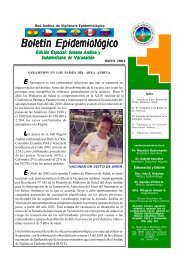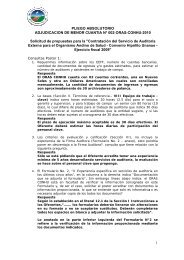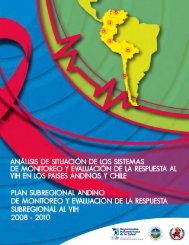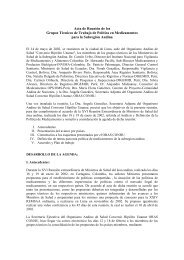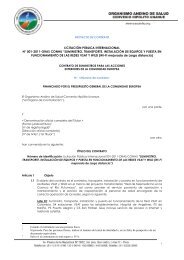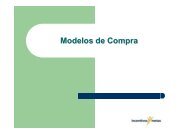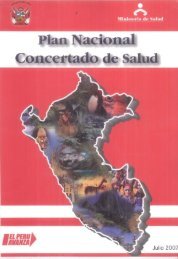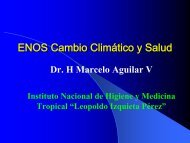diagnóstico del dengue - Organismo Andino de Salud
diagnóstico del dengue - Organismo Andino de Salud
diagnóstico del dengue - Organismo Andino de Salud
You also want an ePaper? Increase the reach of your titles
YUMPU automatically turns print PDFs into web optimized ePapers that Google loves.
Estado Plurinacional <strong>de</strong> Bolivia<br />
Ministerio <strong>de</strong> <strong>Salud</strong> y Deportes<br />
“REUNION ANDINA PARA ACCION<br />
CONJUNTA CONTRA EL DENGUE”<br />
PROGRAMA NACIONAL DE<br />
ENFERMEDADES TRANSMITIDAS POR<br />
VECTORES- DENGUE<br />
2012
No <strong>de</strong> Casos<br />
Relación <strong>de</strong> Casos sospechosos<br />
y confirmados <strong>de</strong> Dengue<br />
Bolivia – 1997 – 2012*<br />
90000<br />
80000<br />
70000<br />
60000<br />
50000<br />
40000<br />
30000<br />
20000<br />
10000<br />
0<br />
1997 1998 1999 2000 2001 2002 2003 2004 2005 2006 2007 2008 2009 2010 2011 2012<br />
Sospechosos 262 534 332 118 340 892 6601 7380 4443 2555 7332 7807 84047 6620 44804 26587<br />
Confirmados 54 228 49 27 27 278 1045 685 618 583 2186 2212 7421 1136 7690 4851<br />
Años<br />
Fuente: Programa Nacional <strong>de</strong> Dengue
Numero <strong>de</strong> casos<br />
Tasa <strong>de</strong> letalidad<br />
LETALIDAD NACIONAL POR DENGUE<br />
BOLIVIA, 2008 - 2012 *<br />
9000<br />
8000<br />
7000<br />
6000<br />
5000<br />
25,0<br />
20,0<br />
15,0<br />
4000<br />
3000<br />
2000<br />
1000<br />
0<br />
2008 2009 2010 2011 2012*<br />
Dengue 2212 7421 1136 7690 4851<br />
Letalidad 1,5 6,7 13,3 13,5 19,3<br />
10,0<br />
5,0<br />
0,0<br />
FUENTE: Programa Nacional <strong>de</strong> Dengue
No <strong>de</strong> Casos<br />
Tasa <strong>de</strong> Letalidad<br />
CASOS DE DENGUE SIN SIGNOS DE ALARMA – DENGUE GRAVE – DECESOS Y<br />
TASA DE LETALIDAD POR SEMANA EPIDEMIOLOGICA<br />
BOLIVIA, ENERO – ABRIL, 2012<br />
450<br />
400<br />
350<br />
300<br />
250<br />
200<br />
150<br />
100<br />
50<br />
0<br />
CLASIFICACION DENGUE DENGUE GRAVE<br />
PROBABLE 21.884 (81%) 142 (81%)<br />
CONFIRMADO 4.851 (19%) 34(19%)<br />
ACUMULADO 26.735(100%) 176 (100%)<br />
TOTAL<br />
1 2 3 4 5 6 7 8 9 10 11 12 13 14 15 16 17<br />
Dengue 219 248 231 301 322 375 418 381 357 378 360 237 286 273 301 153 11<br />
Dengue grave 10 12 11 8 3 4 13 7 7 4 49 38 0 4 0 6<br />
Decesos 2 3 4 6 2 3 4 3 4 2 1 1 0 0 0 0<br />
Tasa <strong>de</strong> Letalidad 20 25 36 75 67 75 31 43 57 50 2 3 0 0 0 0<br />
Total casos<br />
80<br />
70<br />
60<br />
50<br />
40<br />
30<br />
20<br />
10<br />
0
DISTRIBUCIÓN DE CASOS DE DENGUE Y DENGUE<br />
GRAVE<br />
BOLIVIA, ENERO – ABRIL, 2012<br />
DEPARTAMENTO<br />
Casos <strong>de</strong><br />
Dengue<br />
Dengue<br />
Grave<br />
Total<br />
Casos Porcentaje<br />
BENI 399 8 407 8,1<br />
COCHABAMBA 364 35 399 7,9<br />
LA PAZ 373 1 374 7,4<br />
SANTA CRUZ 3396 121 3517 70,0<br />
TARIJA 191 9 200 4,0<br />
CHUQUISACA 126 2 128 2,5<br />
PANDO 2 0 2 0,0<br />
Total general 4851 176 5027 100<br />
FUENTE: Programa Nacional <strong>de</strong> Dengue
Fuente: Programa Nacional <strong>de</strong> Dengue
FUENTE: Programa Nacional <strong>de</strong> Dengue
DIAGNÓSTICO DEL DENGUE<br />
Conformación <strong>de</strong> la red<br />
<strong>de</strong> laboratorios<br />
en 25 municipios<br />
endémicos.<br />
FUENTE: Programa Nacional <strong>de</strong> Dengue
FORTALEZAS:<br />
1. Vigilancia Epi<strong>de</strong>miológica:<br />
- Implementación <strong><strong>de</strong>l</strong> formulario <strong>de</strong> registro individual <strong>de</strong><br />
pacientes con Dengue.<br />
- Análisis y diseño <strong><strong>de</strong>l</strong> sistema <strong>de</strong> información (Software) a nivel<br />
nacional.<br />
- Estandarización <strong>de</strong> la ficha entomológica para realizar las<br />
encuestas.<br />
- Conformación <strong>de</strong> la Red <strong>de</strong> laboratorios <strong>de</strong> diagnóstico <strong>de</strong><br />
Dengue conformada por 20 laboratorios con la capacidad <strong>de</strong><br />
diagnóstico <strong>de</strong> <strong><strong>de</strong>ngue</strong> mediante pruebas rápidas y 5<br />
laboratorios con capacidad <strong>de</strong> diagnosticar Mac ELISA-Dengue.
FORTALEZAS:<br />
2. Prevención y control <strong>de</strong> brotes<br />
•Dotación <strong>de</strong> larvicidas e insecticidas a las regiones endèmicas.<br />
•Dotación <strong>de</strong> pruebas rápidas para el diagnóstico <strong>de</strong> Dengue.<br />
•Dotación <strong>de</strong> reactivos para el diagnóstico <strong>de</strong> Dengue mediante<br />
la técnica Mac ELISA.<br />
3. Participación y movilización social<br />
•Diseño <strong>de</strong> la estrategia <strong>de</strong> comunicación basada en la<br />
metodología COMBI.<br />
•Autorida<strong>de</strong>s locales comprometidas para <strong>de</strong>sarrollar la gestión<br />
intersectorial necesaria en el control <strong><strong>de</strong>l</strong> <strong><strong>de</strong>ngue</strong>.<br />
•Movilización social enmarcada <strong>de</strong>ntro <strong>de</strong> la política SAFCI (<strong>Salud</strong><br />
Familiar Comunitaria e Intercultural)
4. Organización <strong>de</strong> los servicios <strong>de</strong> salud y atención <strong>de</strong> pacientes<br />
Consultorio <strong>de</strong> Triage:<br />
Diagnostica y clasifica a los<br />
pacientes con <strong><strong>de</strong>ngue</strong>, <strong><strong>de</strong>ngue</strong><br />
grave, <strong>de</strong>fine el grupo :<br />
Grupo<br />
A<br />
Grupo<br />
B<br />
Grupo<br />
C<br />
Manejo domiciliario<br />
Ser hospitalizado<br />
Requiere tratamiento <strong>de</strong><br />
emergencia<br />
y <strong>de</strong>ci<strong>de</strong> el manejo:<br />
Nivel I Nivel II Nivel III<br />
50 médicos que trabajan en<br />
centros <strong>de</strong> salud <strong>de</strong> I y II nivel <strong>de</strong><br />
las regiones endémicas fueron<br />
actualizados en el manejo clínico<br />
<strong>de</strong> pacientes con <strong><strong>de</strong>ngue</strong>.<br />
Diagnóstico gratuito <strong>de</strong> <strong><strong>de</strong>ngue</strong><br />
mediante pruebas rápidas y Mac<br />
ELISA.<br />
Dotación <strong>de</strong> insumos a las<br />
regionales endémicas para la<br />
atención <strong>de</strong> pacientes con<br />
<strong><strong>de</strong>ngue</strong> grave.<br />
Elaboración y distribuciòn <strong>de</strong> la<br />
Guía <strong>de</strong> atención <strong>de</strong> pacientes<br />
con Dengue.
DIFICULTADES Y OBSTÁCULOS<br />
‣ Carencia <strong>de</strong> laboratorios para la realización PCR-RT y<br />
serotipicación <strong><strong>de</strong>l</strong> virus <strong><strong>de</strong>l</strong> <strong><strong>de</strong>ngue</strong>. Solo el laboratorio<br />
<strong>de</strong> virología <strong>de</strong> CENETROP realiza la serotipificaciòn a<br />
nivel nacional.<br />
‣ Carencia <strong><strong>de</strong>l</strong> sistema <strong>de</strong> información (Software) para<br />
la notificación inmediata a nivel nacional.<br />
‣ Carencia <strong>de</strong> estandarización <strong>de</strong> la ficha entomológica<br />
para realizar las encuestas.<br />
‣ Falta <strong>de</strong> compromiso <strong>de</strong> algunas autorida<strong>de</strong>s<br />
municipales en el recojo <strong>de</strong> inservibles y eliminación <strong>de</strong><br />
cria<strong>de</strong>ros.
MEDIDAS IMPLEMENTADAS EN<br />
SITUACION ACTUAL :<br />
1. Preparatorias<br />
2. Durante los brotes
PROPUESTAS PARA COOPERACIÓN<br />
TÉCNICA ENTRE PAISES<br />
‣Cooperación técnica para la estandarización <strong>de</strong> la vigilancia<br />
entomológica y control vectorial en regiones fronterizas.<br />
‣Cooperación en la capacitación para la implementación <strong>de</strong><br />
la metodología <strong>de</strong> vigilancia entomológica en aéreas urbanas.<br />
‣Realización <strong>de</strong> estudios <strong>de</strong> resistencia y susceptibilidad <strong>de</strong><br />
Ae<strong>de</strong>s a los insecticidas en regiones fronterizas.<br />
‣Cooperación para la implementación <strong>de</strong> laboratorios con<br />
capacidad <strong>de</strong> realizar la serotipificación <strong><strong>de</strong>l</strong> virus <strong>de</strong> <strong><strong>de</strong>ngue</strong><br />
en zonas endémicas fronterizas.
Gracias …


